Hitachi Deskstar 7K1000: Terabyte Storage arrives on the Desktop
by Gary Key on March 19, 2007 8:00 AM EST- Posted in
- Storage
iPeak Business Application Tests
Our iPeak Winstone benchmarks offer a glimpse into how well our hard disk drives will handle general office applications, media encoding, and graphics manipulation. While the business applications that are being tested tend to be more CPU bound at times, the performance of the hard drive can and will make a difference in the more disk intensive video and graphics applications where large media files are typically being edited.
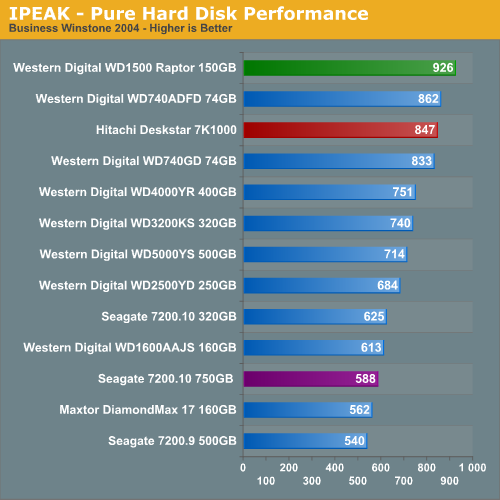
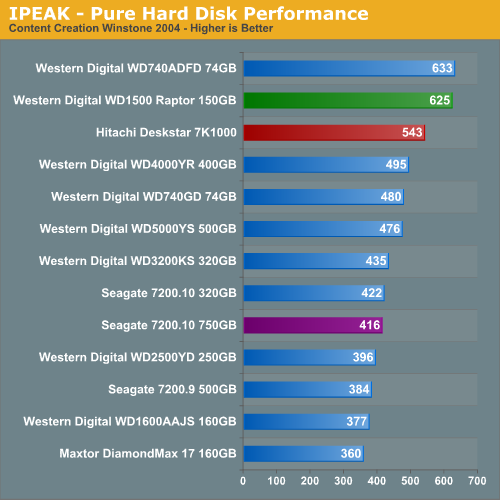
AAs expected the WD Raptor drives finish at the top in our business application tests as their 10k rpm spindle speed and optimized cache play an important role in their ability to sustain high transfer rates, especially in the Content Creation benchmark where transfer block sizes are significantly larger and more random than in the Business application benchmark. We see our 7K1000 performing very well in these tests and finishing ahead of the other 7200rpm drives and even the older 8 MB cache equipped 74GB Raptor.
In fact, the 7K1000 is about 44% faster in the Business Winstone and 30% quicker in the Content Creation benchmarks than the Seagate 750GB drive. After reviewing the trace analysis files we determined that the 7K1000 handles small block sizes of data in non-sequential order significantly better than the Seagate drive. We did notice the drive slowed down slightly in the Business Winstone when it encountered large block sizes of data in non-sequential order. This surprised us slightly as we expected the increase in drive cache to 32 MB would have buffered this same issue we noticed on the Seagate 750GB drive. Overall, the drive offers a very balanced blend of performance across a wide variety of business and home applications.
iPeak General Task Tests
The iPeak based General Task benchmarks are designed to replicate utility based application tasks that typically are disk intensive and represent common programs utilized on the majority of personal computers. While the WinRAR program is very CPU intensive it will typically stress the storage system in short bursts. Our antivirus benchmark will stress the storage system with continual reads and sporadic write requests while the defragmentation process is split between continual read and write requests.
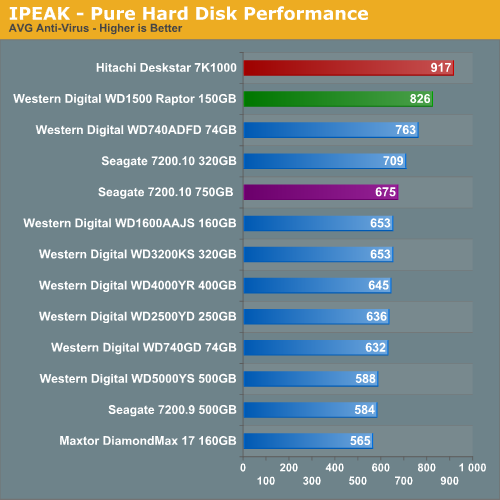
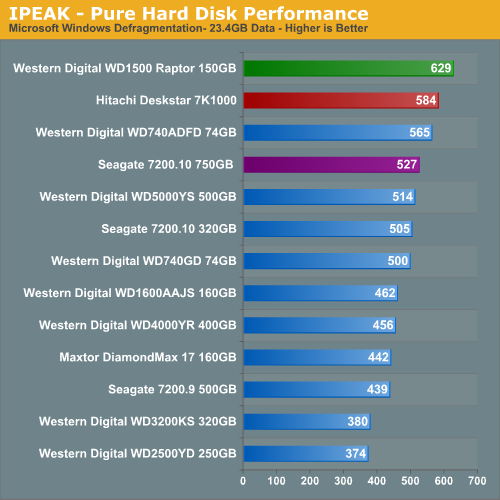
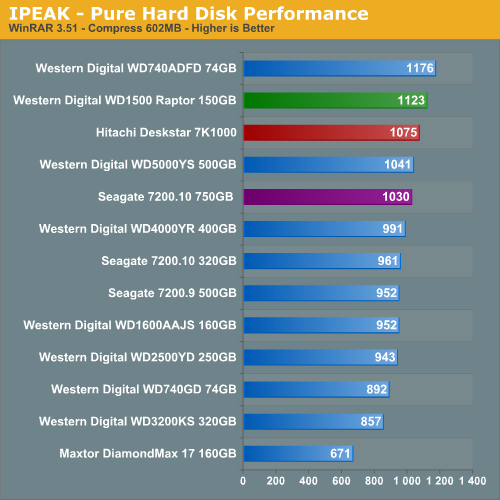
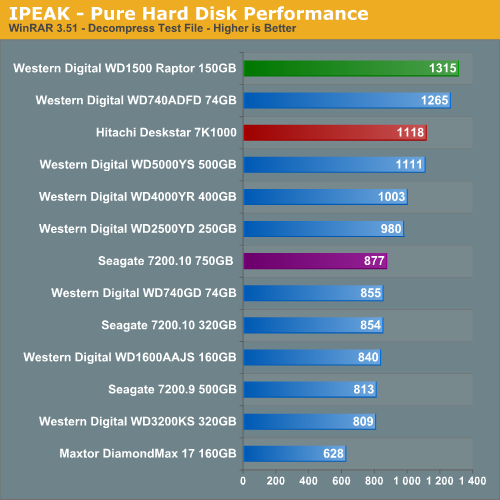
The 7K1000 performs extremely well in the Anti-Virus and Defragmentation test where its 32 MB cache benefits read operations with results that mirror the PCMark 2005 tests. This is especially true in the WinRAR tests where large cache sizes are very advantageous for improved times and we expected better performance from this drive. It did finish ahead of the other 7200rpm drives but simply could not keep up with the rotational and access speeds of the 16 MB cache equipped Raptors.
Our iPeak Winstone benchmarks offer a glimpse into how well our hard disk drives will handle general office applications, media encoding, and graphics manipulation. While the business applications that are being tested tend to be more CPU bound at times, the performance of the hard drive can and will make a difference in the more disk intensive video and graphics applications where large media files are typically being edited.


AAs expected the WD Raptor drives finish at the top in our business application tests as their 10k rpm spindle speed and optimized cache play an important role in their ability to sustain high transfer rates, especially in the Content Creation benchmark where transfer block sizes are significantly larger and more random than in the Business application benchmark. We see our 7K1000 performing very well in these tests and finishing ahead of the other 7200rpm drives and even the older 8 MB cache equipped 74GB Raptor.
In fact, the 7K1000 is about 44% faster in the Business Winstone and 30% quicker in the Content Creation benchmarks than the Seagate 750GB drive. After reviewing the trace analysis files we determined that the 7K1000 handles small block sizes of data in non-sequential order significantly better than the Seagate drive. We did notice the drive slowed down slightly in the Business Winstone when it encountered large block sizes of data in non-sequential order. This surprised us slightly as we expected the increase in drive cache to 32 MB would have buffered this same issue we noticed on the Seagate 750GB drive. Overall, the drive offers a very balanced blend of performance across a wide variety of business and home applications.
iPeak General Task Tests
The iPeak based General Task benchmarks are designed to replicate utility based application tasks that typically are disk intensive and represent common programs utilized on the majority of personal computers. While the WinRAR program is very CPU intensive it will typically stress the storage system in short bursts. Our antivirus benchmark will stress the storage system with continual reads and sporadic write requests while the defragmentation process is split between continual read and write requests.




The 7K1000 performs extremely well in the Anti-Virus and Defragmentation test where its 32 MB cache benefits read operations with results that mirror the PCMark 2005 tests. This is especially true in the WinRAR tests where large cache sizes are very advantageous for improved times and we expected better performance from this drive. It did finish ahead of the other 7200rpm drives but simply could not keep up with the rotational and access speeds of the 16 MB cache equipped Raptors.










74 Comments
View All Comments
mikeg - Thursday, April 26, 2007 - link
Its been a over a month since the article came out and I still don't see any in the retail stores or a non OEM drive. Where can I get one?? Anyone see a retail box of these drives a a retailer? I want to get a coupleMike
jojo4u - Monday, March 26, 2007 - link
Hello Gary,the Hitachi datasheet refers to three idle modes using APM. The results with AAM enabled could suggest that APM is automatically engaged with AAM. So perhaups one should check the APM level with Hitachi's Feature Tool or the generic tools http://hdparm-win32.dyndns.org/hdparm/">hdparm or hddscan.
Gary Key - Friday, March 30, 2007 - link
We had a lengthy meeting with the Hitachi engineers this week to go over APM and AAM modes along with the firmware that is shipping on the Dell drives. I hope to have some answers next week as testing APM capabilities on a Dell based system resulted in a slightly different behavior than our test bench. I have completed the balance of testing with various AAM/NCQ on/off combinations and some additional benchmark tests. I am hoping to update the article next week. Also, I ran acoustic tests in a different manner and will have those results available. Until, then I did find out that sitting a drive on a foam brick outside of a system and taking measurements from the top will mask some of the drives acoustic results. The majority of noise emitted from this drive comes from the bottom, not the top. ;)ddarko - Monday, March 26, 2007 - link
"However, Hitachi has informed us they have the capability to go to 250GB per-platter designs but launched at smaller capacities to ensure their reliability rate targets were met. Considering the absolute importance of data integrity we think this was a wise move."This sounds like an sneaky attempt by Hitachi to raise doubt about the safety of Seagate's forthcoming 1TB drive. Where is the data to support this rather bold statement that 250GB platters designs are not as capable as 200GB designs of meeting these completely unspecified "reliability rate targets"? What does that even mean? Can we infer that 150GB platter designs are even more reliable than 200GB designs? It's disappointing to see the review accept Hitachi's statement without question, going so far as to even applaud Hitachi for its approach without any evidence whatsoever to back it.
Lord Evermore - Thursday, March 22, 2007 - link
While I know memory density in general isn't increasing nearly as fast as hard drive size, 32MB cache seems pretty chintzy for a top-end product. I suppose 16MB on the 750GB drives is even worse.My first 528MB hard drive with a 512KB cache was a 1/1007 ratio (using binary cache size, and labelled drive size which would be around binary 512MB). Other drives still had as little as 128KB cache, so they could have been as little as a 1/4028 ratio, but better with smaller drives. I think anything larger than 512MB always had 512KB.
A 20GB drive with 2MB cache is 1/9536 ratio.
A 100GB drive with 2MB cache is 1/47683.
Then the jump to 8MB cache makes the ratio much better at 1/11920 for a 100GB drive (I'm ignoring the lower-cost models that had higher capacities, but still 2MB cache). Then it gets progressively worse as you get up to the 500GB size drives. Then we make another cache size jump, and the 160GB to 500GB models have a 16MB option, which is back to 1/9536 on a 160GB, to 1/29802 on a 500GB.
The trend here being that we stick with a particular cache size as drive size increases so the ratio gets worse and worse, then we make a cache size jump which improves the ratio and it gets worse again, then we make another cache size jump again.
Now we go to 750GB drives with 16MB cache. Now we are up to a 1/44703 ratio, only the 2nd worse ever, seems like time for another cache increase. Jumping to 32MB with a 100TB drive only makes it 1/29802. Not a very significant change despite doubling the cache again, since the drive size also increased, and it'll only get worse as they increase the drive size. Even 32MB on a 750GB drive is 1/22351, only slightly better than the 16MB/500GB flagship drives when they came out, and we don't even HAVE a 32MB/750GB drive.
A 512MB cache would be nice. That's still not the best ratio ever, it's still 1/1862, but that's a heck of a lot better than 1/30,000th. At the very least, they need to jump those cache chip densities a lot, or use more than one. Even a single 512MB density chip would be 64MB, still not great but better.
Per Hansson - Sunday, March 25, 2007 - link
Bigger caches would almost make it a necessity that you run the system on a UPS.Loosing 32mb of data that is yet to be written to the platters is allot, but 512mb?
And the UPS would not take into account OS crashes...
I'm not sure how much this would affect performance either, but a review of a SCSI drive with a SCSI controller with 2mb - 1gb of cache would answer that question well...
yehuda - Wednesday, March 21, 2007 - link
Do they plan to launch a single platter variant sometime in the near future?Gary Key - Wednesday, March 21, 2007 - link
They will be releasing a 750GB variant in May. Our initial reports have the single platter drives along with the 300~500GB models coming later in the summer. I am trying to get that confirmed now.DeathSniper - Tuesday, March 20, 2007 - link
Last page..."The Achilles heal of the Seagate 750GB drive..."I think it should be heel, not heal ;)
Spacecomber - Tuesday, March 20, 2007 - link
While this drive has enough in the way of other features to make it stand out from the crowd, I was a bit surprised to see that Hitachi hadn't upped the warranty to 5 years for this drive, which is what Seagate offers on most of their drives and WD offers on their raptors.